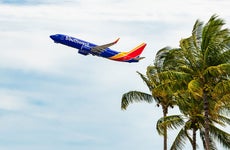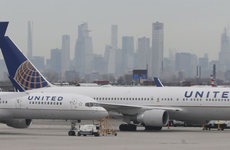Best credit cards for flight upgrades to first class

The Bankrate promise
At Bankrate we strive to help you make smarter financial decisions. While we adhere to strict , this post may contain references to products from our partners. Here's an explanation for . The content on this page is accurate as of the posting date; however, some of the offers mentioned may have expired. Terms apply to the offers listed on this page. Any opinions, analyses, reviews or recommendations expressed in this article are those of the author’s alone, and have not been reviewed, approved or otherwise endorsed by any card issuer.
The Bank of America content was updated on January 17, 2024.
- When choosing a travel credit card for first-class upgrades, you can choose a general travel credit card with transferable rewards or you can choose an airline credit card.
- With an airline credit card, you'll have a smooth path toward first-class upgrades, and you'll often receive several other airline-specific perks.
- If you're looking for a general travel credit card that isn't focused on a specific airline, make sure the card lets you transfer your rewards to various airline loyalty programs.
- For the best odds of grabbing a first-class upgrade on your next flight, consider earning airline elite status, looking for less-busy flight options or even paying for upgrades with credit card rewards.
Nothing beats the luxury of first class — you can enjoy a roomy seat while sipping champagne, which can make even the longest of flights enjoyable. Generally speaking, if you want to fly first class, you can either pay full price for a ticket or hope for an upgrade.
Although first-class flight upgrades aren’t as common as they used to be, it’s still possible for people with elite airline status to get rewarded for their loyalty with a bump into first class. With a good travel credit card, earning those upgrades becomes even easier. And if you aren’t automatically upgraded, you can always use your credit card rewards to upgrade yourself.
Here are some of the best credit cards for first-class upgrades:
Alaska Airlines Visa Signature credit card: Best for Alaska Airlines
The Alaska Airlines Visa® credit card, which comes with a $95 annual fee, earns an unlimited 3X miles for spending on eligible Alaska Airlines purchases; 2X miles on eligible gas purchases, cable purchases, streaming services and local transit purchases; and 1X miles on all other purchases. New cardmembers can also earn a limited-time online welcome offer, which includes 70,000 bonus miles plus Alaska’s Famous Companion Fare™ ($99 fare plus taxes and fees from $23) with this offer. To qualify, make $3,000 or more in purchases within the first 90 days of opening your account.
Delta SkyMiles Gold American Express Card: Best for Delta Air Lines
The Delta SkyMiles® Gold American Express Card earns 2X miles on eligible Delta purchases, 2X miles at restaurants (plus takeout and delivery in the U.S.) and U.S. supermarkets and 1X miles on all other purchases. Plus, you’ll get a $0 intro annual fee for the first year (then an annual fee of $99 per year), no foreign transaction fees and other card perks. For a welcome offer, you can earn 60,000 bonus miles after you spend $2,000 in your first three months.
Delta SkyMiles Blue American Express Card: Best for Delta Air Lines with no annual fee
The Delta SkyMiles® Blue American Express Card earns 2X miles on eligible Delta purchases, 2X miles at restaurants worldwide (plus takeout and delivery in the U.S.) and 1X miles on all other eligible purchases. This card also comes with a $0 annual fee, no foreign transaction fees, and a welcome offer of 10,000 bonus miles after spending $1,000 within the first six months.
Chase Sapphire Preferred Card: Best for travel card beginners
The Chase Sapphire Preferred® Card, which is a general travel credit card, is a good fit for those new to travel credit cards. It comes with a $95 annual fee, along with a welcome offer of 60,000 bonus points after spending $4,000 on purchases within the first three months. Also, note that points are worth 25 percent more when redeemed for travel through Chase Ultimate Rewards.
Cardholders will earn 5X points on travel purchased through Chase Ultimate Rewards; 5X total points on Lyft rides (through March 31, 2025); 3X points on dining (including eligible delivery services), select streaming services and online grocery purchases (excluding Walmart, Target and wholesale clubs); 2X points on other travel purchases; and 1X points on all other purchases.
Chase Sapphire Reserve: Best for luxury travelers
The Chase Sapphire Reserve® is a general travel rewards card that’s best suited for luxury travelers since it comes with a high annual fee of $550. This card also includes a welcome bonus of 60,000 points after spending $4,000 on purchases within the first three months, along with no foreign transaction fees and numerous travel-related statement credits and benefits. Plus, points are worth 50 percent more when redeemed for travel through Chase Ultimate Rewards.
For rewards, you’ll earn 10X points on hotel stays, car rentals and Chase Dining purchases through Chase Ultimate Rewards; 10X total points on Lyft purchases (through March 31, 2025); 5X points on air travel through Ultimate Rewards; 3X points on restaurant and general travel purchases and 1X points on all other purchases.
How to choose a credit card for airline upgrades
When choosing a travel credit card for first-class upgrades, you’ll have two main options: You can choose a general travel credit card, such as the Chase Sapphire Preferred Card, or you can choose an airline credit card, such as the Delta SkyMiles Gold American Express Card.
With an airline credit card, you’ll have a smooth path toward first-class upgrades, and you’ll often receive several other airline-specific perks such as free checked bags, lounge access and companion tickets. Airline credit cards also typically give you higher rewards rates when you book through the airline, which is one more incentive to help you become a frequent flyer and earn elite status.
If you’re looking for a general travel credit card that isn’t focused on a specific airline, make sure the card lets you transfer your rewards to various airline loyalty programs. That way, you can redeem those rewards for first-class upgrades through different airlines.
How to improve your chances of a flight upgrade
Pick an airline and work your way up to elite status
Airlines reward their most loyal customers, so it’s time to choose an airline and become a frequent flyer. Make sure the airline services the airports you’re most likely to fly into. For example, you probably don’t want to pick Alaska Airlines if you’re located in the Midwest. If you’re an international traveler, avoid small, primarily domestic carriers and look for a major airline that can get you across the globe.
Once you’ve chosen your airline, use it for every trip. Yes, you might find a flight that’s a few dollars cheaper on a competing carrier, but building elite status with an airline comes with its own rewards — including occasional first-class upgrades.
Avoid busy flights
To get a free first-class upgrade, you’re going to want to be on a plane that has empty seats in first class. That means skipping busy flights in favor of less popular ones. How can you tell which flights are the most popular? Look at the price. The cheaper the flight, the less popular it’s likely to be.
If you can book flights during the middle of the week, you’ll have a better chance of finding an empty seat in first class. Midweek flights are also less popular with business-class flyers, which is good for you because business-class tickets often get upgraded to first class before coach tickets. The fewer business-class passengers on your flight, the more likely you’ll get upgraded.
Pay for your upgrade with points or miles
You’re going to be competing with a lot of other travelers for those first-class upgrades — so the best way to ensure you get one might be to just pay for it. That’s where a good travel credit card can help you. If you have a lot of points or miles on your travel credit card, you can easily upgrade your ticket to first class.
The bottom line
The right travel credit card can improve your odds of first-class upgrades. But if you’re hoping to grab a first-class upgrade on your next flight, there’s a lot more you can do to improve your chances, such as earning elite status, looking for less-busy flights and paying for upgrades with credit card rewards.
Related Articles



